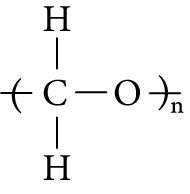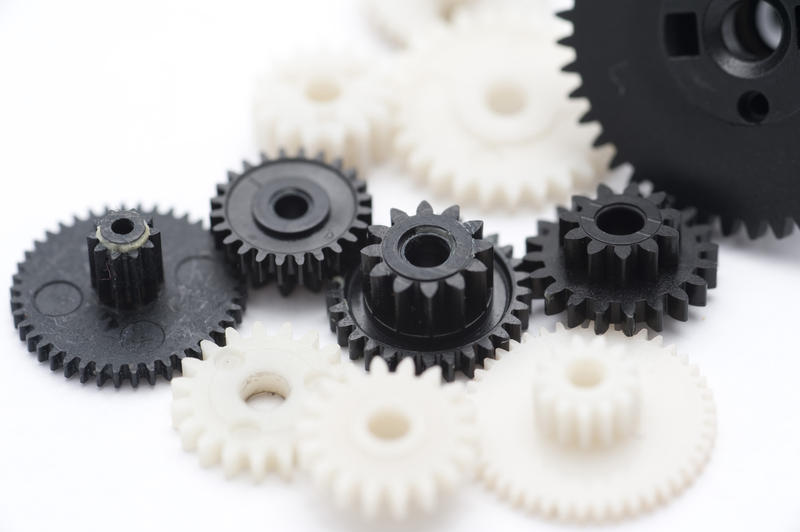Acetals or Polyoxymethylenes (Pom)
The acetals or polyoxymethylenes (POM) are a family of polymers that compete with nylons for many of the same applications, but acetals are not used as commonly as nylons due in part to an instability that causes difficulty during processing. However, for some applications, especially in water, acetals are preferred over nylons. As can be surmised from the simple polymeric repeat unit that has no large pendant groups (Figure 8.4), these polymers are highly crystalline, in fact, they have the highest crystallinity of any thermoplastic polymer family.

Figure 8.4 Polymer repeating unit for acetal or polyoxymethylene (POM).
8.4.1. General Acetal Family Characteristics
The very high degree of crystallinity produces excellent strength, stiffness, surface hardness, barrier properties, solvent resistance, and a sharp melting point. In these properties acetals are generally equivalent to nylon (6/6). The higher crystallinity of acetal reduces the toughness when compared to nylon, but only slightly, so acetals can readily be used in applications requiring some toughness. Acetals are somewhat more notch sensitive than nylons; that is, they fail at a lower impact strength if a notch has been cut in the sample. In spite of this, acetals have good fatigue resistance, as is evidenced by their use as switches in vehicle turn signal indicators.
Although the carbon-oxygen bond in acetal is polar, it is less polar than the carbon-oxygen double bond of nylon and is far less available for secondary bonding because it is between atoms along the backbone rather than pendant to the chain. Hence, acetal is normally not sensitive to polar solvents, as shown by a very low moisture absorption (about 0.22%), which is less than one-tenth the amount of water absorbed by nylon. The dimensional and property changes that characterize nylon in a moist environment are not present with acetal. The properties of acetal are, therefore, more predictable over a wide range of environmental conditions. The only common environmental solvents that have strong action on acetals are acids and strong oxidizing agents. Prolonged contact with these should be avoided. Acetals are used widely in water environments such as toilet tanks, shower heads, hose connections, and valve bodies. Very hot water or steam applications should be avoided because the maximum use temperature is about 212°F (100°C), approximately the same as for nylon.
Its low molecular polarity reduces the tendency of acetal to bond with other materials, and most solvent adhesives are not especially effective. The low bonding tendency gives acetal a low coefficient of friction and a glossy molded surface. These properties are useful in applications such as gears, chain links, conveyor product guides, cams, nonlubricated bearings, automotive window cranks, mounting brackets, and zippers. The good abrasion resistance of acetal further enhances its performance in these applications. Various acetal applications are shown in Photo 8.4. Acetal is sensitive to UV light, which causes a chalking of the surface and degradation of the polymer.

Photo 8.4 Various acetal (POM) parts in the form of gears.
8.4.2. Properties of Specific Acetal Types
Two major types of acetal resins are commonly available, a homopolymer and a copolymer. The homopolymer (the most common brand name is DuPont's Delrin®) is made by the polymerization of formaldehyde. This polymer is very susceptible to thermal degradation by depolymerizing (unzipping the molecule) along with the release of formal-dehyde, a potentially toxic and flammable gas. To reduce the tendency to degradation, a chemical is added to the polymer that reacts with the ends of the polymer molecules. This process, called endcapping, is used to stabilize acetals and a few other polymers.
The copolymer (the most common brand names are Celanese's Celcon® and Hoescht's Hostaform®) is made by the copolymerization of formaldehyde with ethylene oxide or by the ring-opening polymerization of dioxane with ethylene oxide. The resulting structure differs from the homopolymer in that a C—C bond occurs along the backbone along with the C—O—C bonds. The C—C bond interrupts the degradation (unzipping) process and therefore stabilizes the polymer. For additional stability, the copolymer may also be endcapped.
The obvious advantage of the copolymer is improved thermal stability. The copolymer also has more flexibility, twice the elongation, and 20% less water absorption. These are all characteristics to be expected from the addition of the more flexible C—C bond. The homopolymer has the advantages of 15% higher tensile strength, 20% higher modulus, 20% higher impact strength, 20% higher surface hardness, and 20% higher fatigue limit.
Processing the homopolymer is more difficult than processing the copolymer because of the degradation problem, although even the co-polymer is relatively unstable and caution should still be exercised. Safe practice in extrusion, injection molding, and other melt processes dictates that the barrel of the molding machine be cleared of the acetal before shutdown to ensure that the acetal resin is not in the barrel during the subsequent startup, which may overheat the polymer. Further, even temporary shutdowns, as for a mold change or even a problem with the mechanical function of the molding machine, can result in some release of formaldehyde. If the shutdown is for more than a minute or two, the barrel should be purged. Caution should be taken to use acetal polymers only in well-ventilated rooms.
The high crystallinity of acetal introduces some processing modifications as well. To obtain the best properties, the processing cycle in injection molding should allow full crystallinity to occur by keeping the mold hotter than for other resins (such as nylon). (Note: A cold mold is normally used to hasten solidification and thereby reduce the cycle time.) If the mold temperature is too low, the molecules could be trapped in a partially amorphous state in which the amount of crystallinity could vary widely from part to part. Another processing disadvantage of the highly crystalline acetal resins occurs because the melt viscosity doesn't change significantly with temperature. This means that the normal process of reducing the viscosity to improve flow by raising the temperature is not practical. The high crystallinity makes film extrusion so difficult that acetal films are not generally available.
Both the homopolymer and copolymer are easily machined and fabricated. Threaded acetal parts are often machined out of an extruded rod and used in place of machined brass parts. Parts can be assembled by press-fits, snap-fits, cold-heading, and riveting, as well as spin and ultrasonic welding.
Acetal resins can be combined with short fiberglass reinforcements to enhance strength and toughness. Mixtures of acetal with fluorocarbons will enhance the inherently good surface lubricity of acetals.